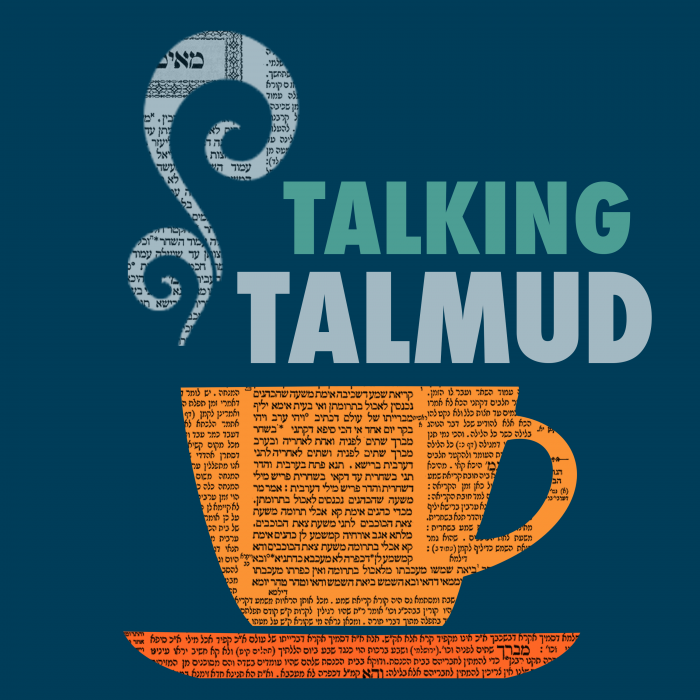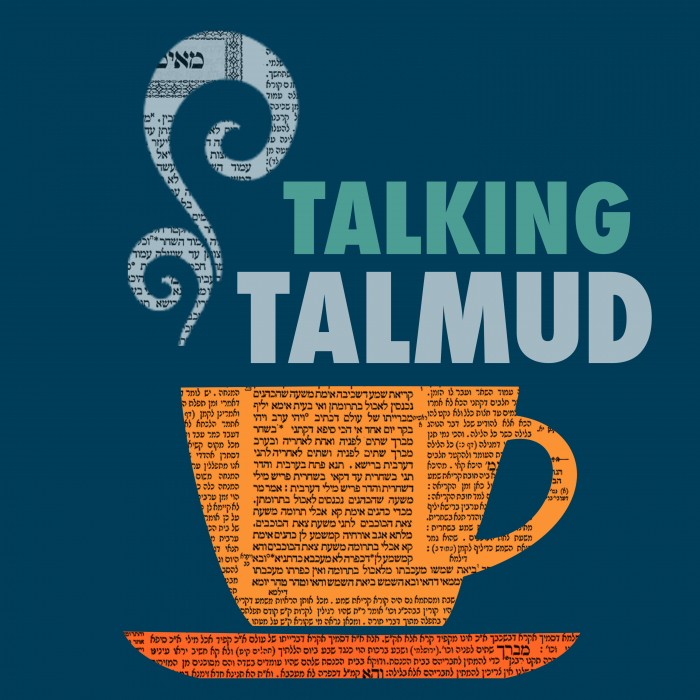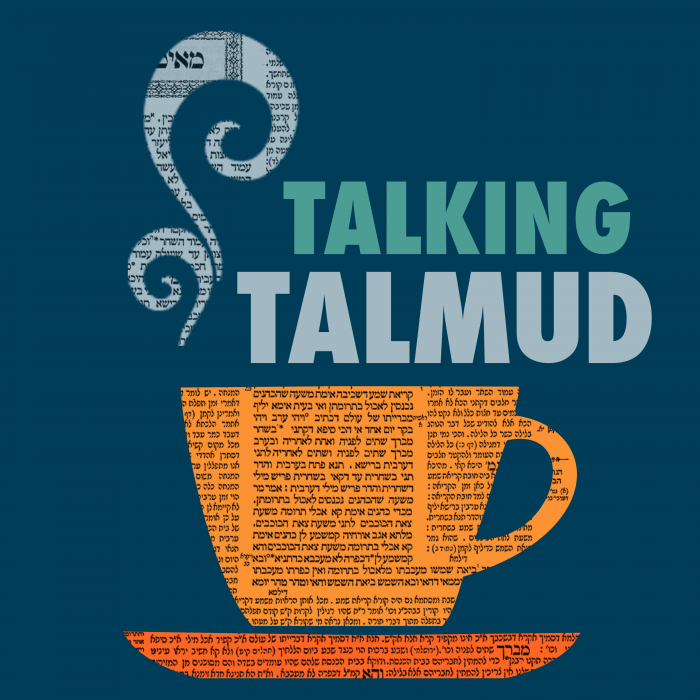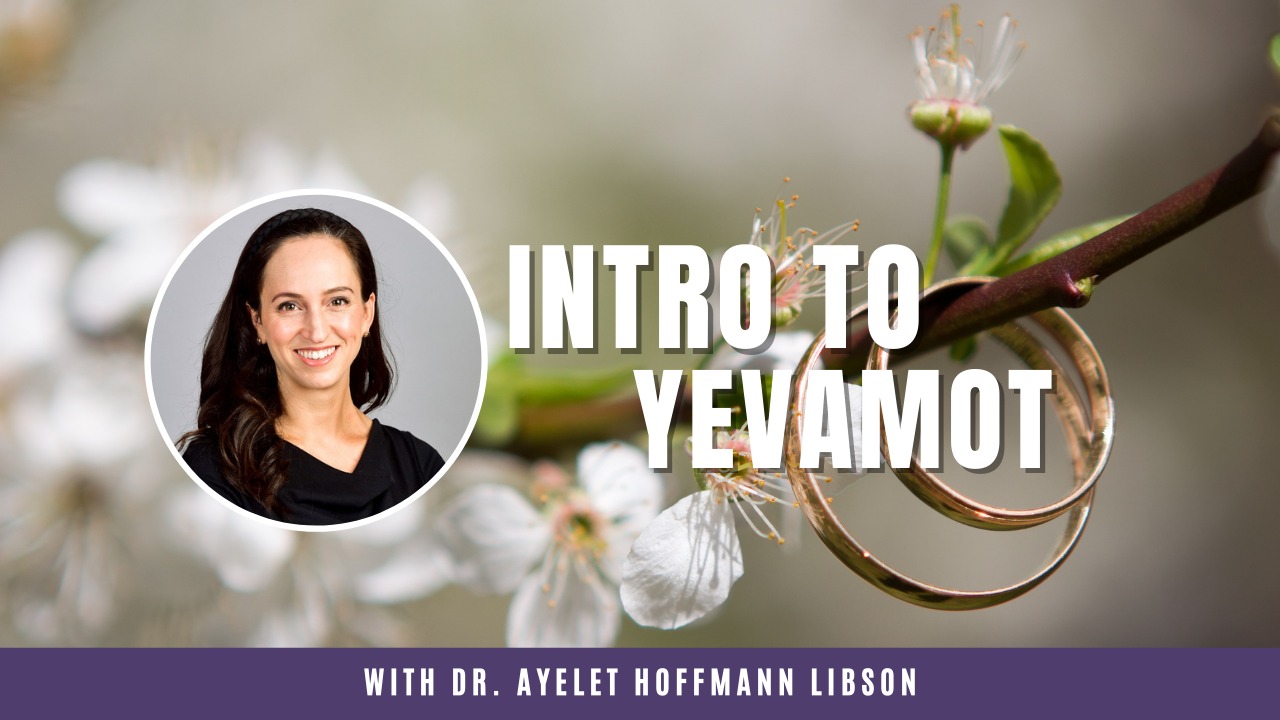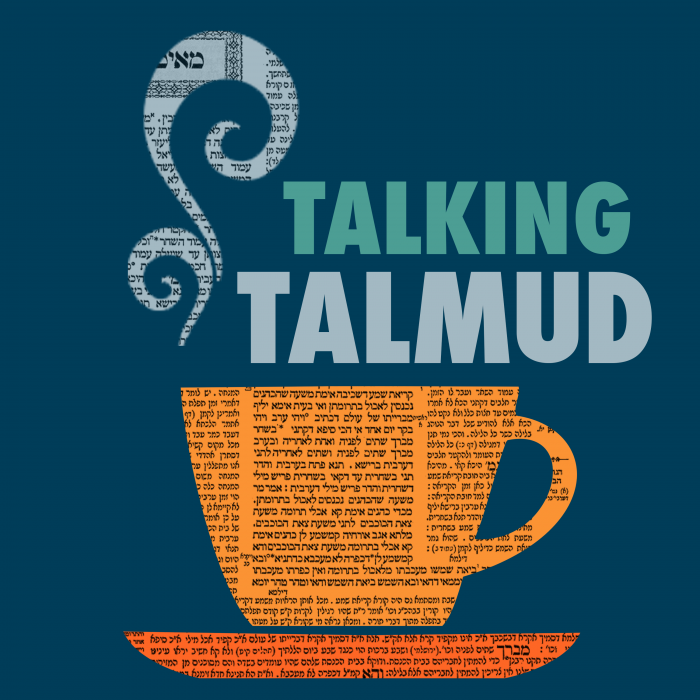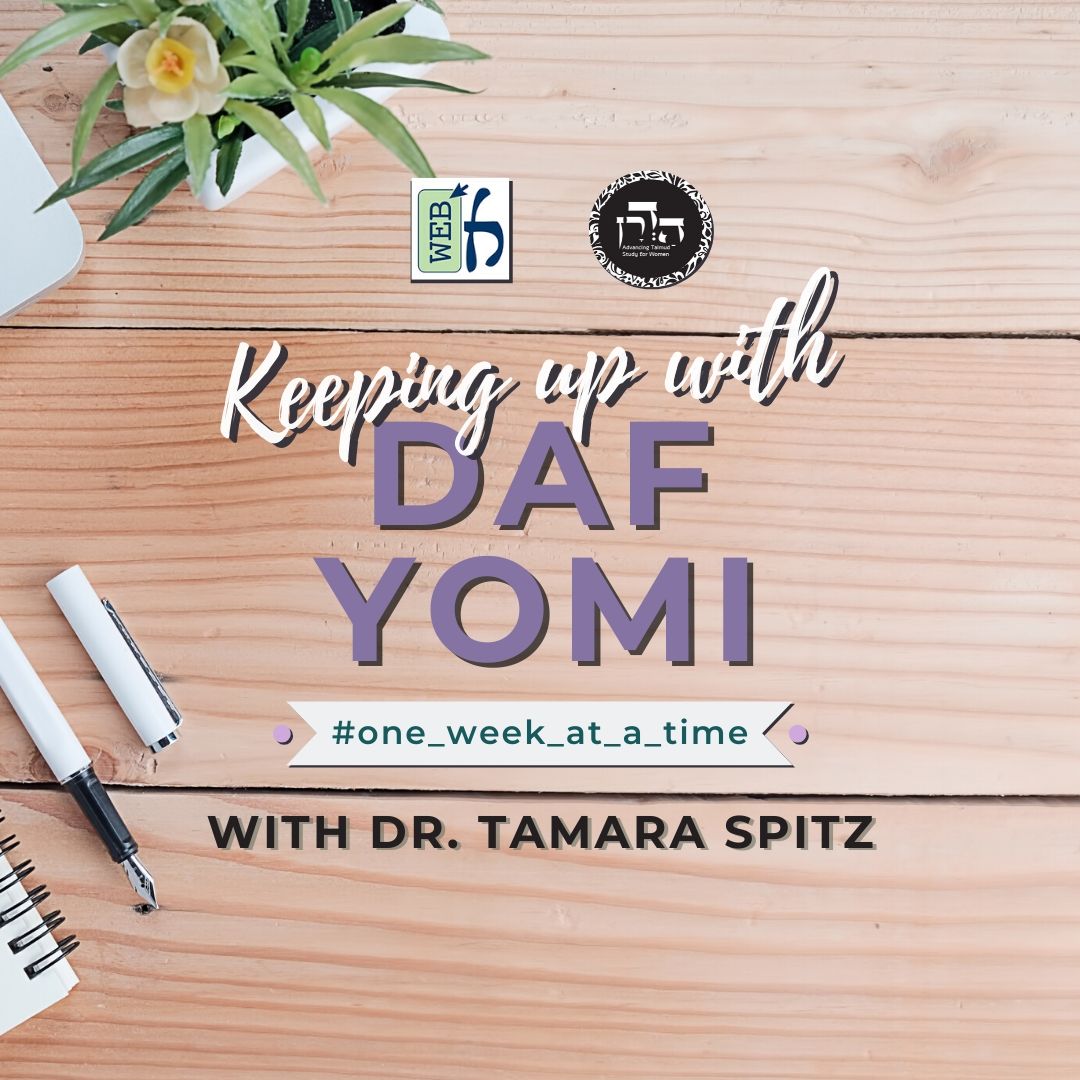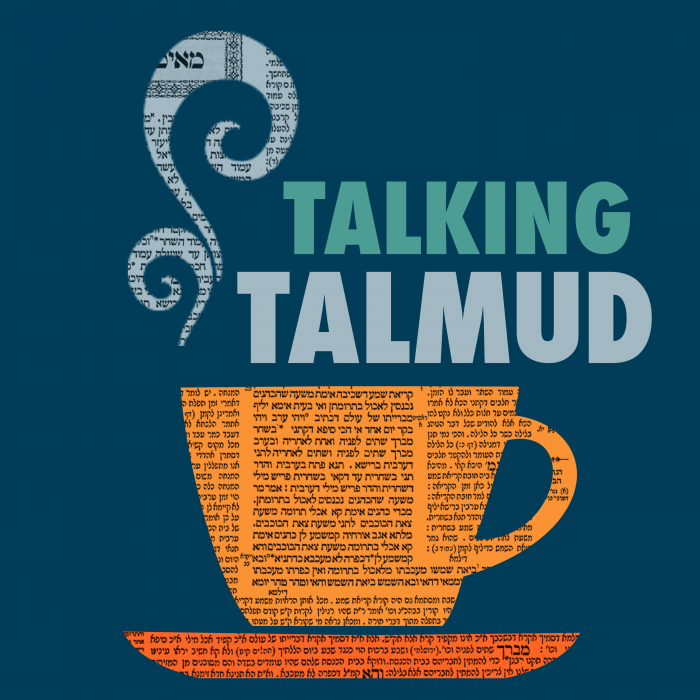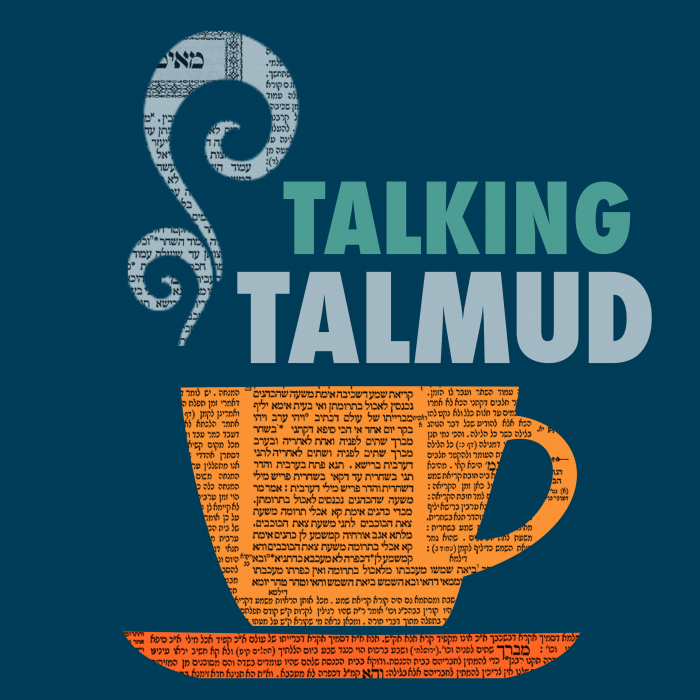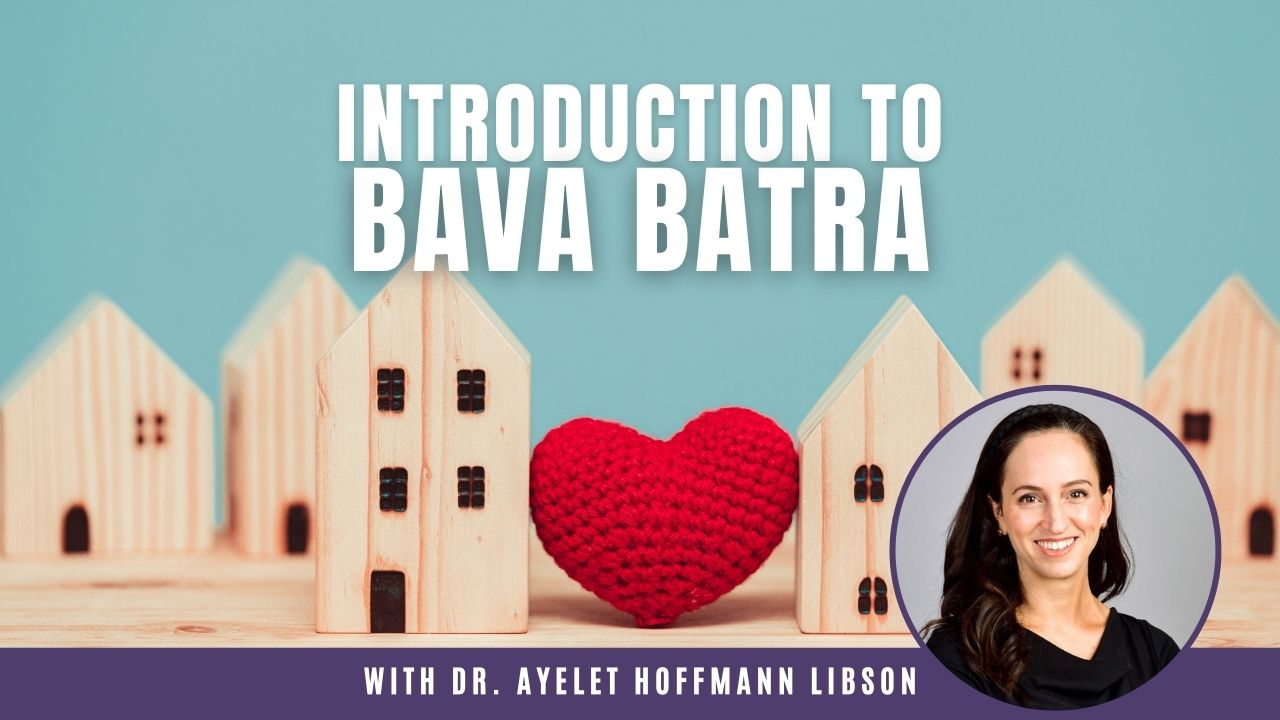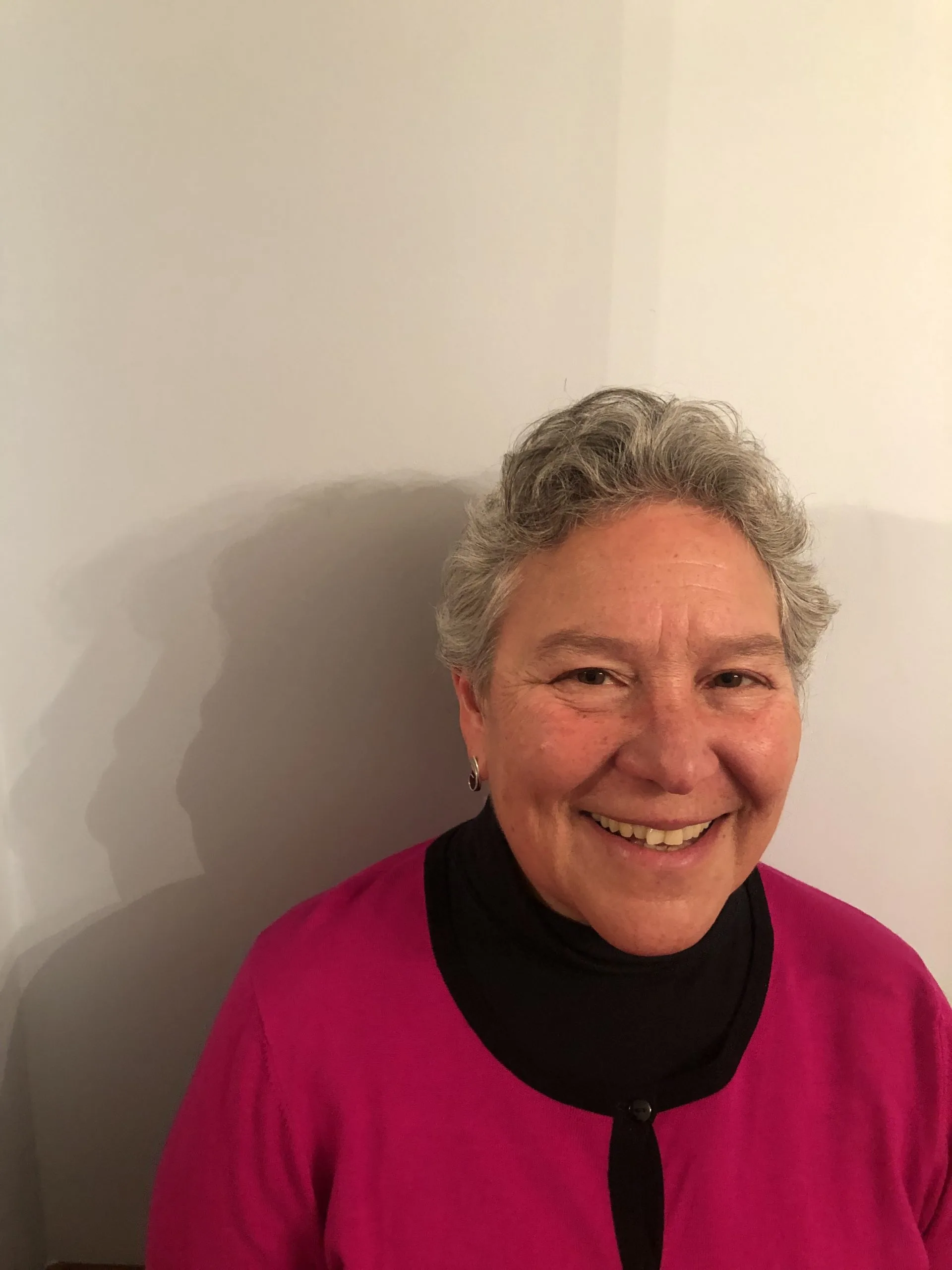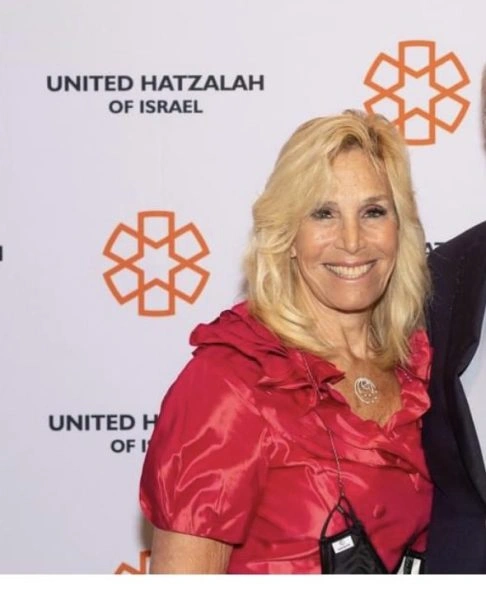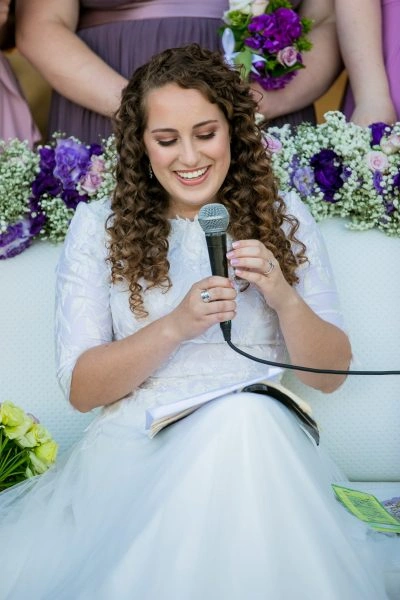Additional blemishes that prevent a priest from working in the temple.
This week’s learning is sponsored by Robert and Paula Cohen in loving memory of Joseph Cohen, Yosef ben Moshe HaCohen, z”l. “He was hard working, loved to sing, esp. as a chazan, and was very dedicated to his family and community.”
Want to dedicate learning? Get started here:


Today’s daily daf tools:
This week’s learning is sponsored by Robert and Paula Cohen in loving memory of Joseph Cohen, Yosef ben Moshe HaCohen, z”l. “He was hard working, loved to sing, esp. as a chazan, and was very dedicated to his family and community.”
Today’s daily daf tools:
Delve Deeper
Broaden your understanding of the topics on this daf with classes and podcasts from top women Talmud scholars.
New to Talmud?
Check out our resources designed to help you navigate a page of Talmud – and study at the pace, level and style that fits you.
The Hadran Women’s Tapestry
Meet the diverse women learning Gemara at Hadran and hear their stories.
Bekhorot 44
אַף עַל פִּי שֶׁאֵינוֹ כּוֹחֵל שְׁתֵּי עֵינָיו כְּאַחַת.
Rather, even if he does not paint both of his eyes as one, any priest with an abnormally sunken nose is considered a ḥarum.
שְׁתֵּי עֵינָיו לְמַטָּה. מָה ״שְׁתֵּי עֵינָיו לְמַעְלָה״ ״שְׁתֵּי עֵינָיו לְמַטָּה״? אִילֵּימָא שְׁתֵּי עֵינָיו לְמַעְלָה — דְּחָזֵי לְמַעְלָה, שְׁתֵּי עֵינָיו לְמַטָּה — דְּחָזֵי לְמַטָּה, עֵינוֹ אַחַת לְמַעְלָה וְעֵינוֹ אַחַת לְמַטָּה — דַּחֲזַאי עֵינוֹ אַחַת לְמַטָּה וְעֵינוֹ אַחַת לְמַעְלָה, הַיְינוּ ״רוֹאֶה אֶת הַחֶדֶר וְאֶת הָעֲלִיָּיה כְּאֶחָת״!
§ The mishna teaches that if both of one’s eyes are above or both of his eyes are below, he is disqualified from performing the Temple service. The Gemara asks: What does the mishna mean when it mentions a priest wherein both of his eyes are above or both of his eyes are below? If we say that the phrase: Both of his eyes are above, means that he constantly gazes upward, and the phrase: Both of his eyes are below, means that he constantly gazes downward, then the case where one of his eyes is above and one of his eyes is below must similarly mean that he gazes with one of his eyes downward and one of his eyes upward. But if so, this is identical to the next case in the mishna, that one sees both the room on the ground floor and the upper story as one.
אֶלָּא, שְׁתֵּי עֵינָיו לְמַעְלָה — דְּקָיְימָן לְמַעְלָה, שְׁתֵּי עֵינָיו לְמַטָּה — דְּקָיְימָן לְמַטָּה, עֵינוֹ אַחַת לְמַעְלָה וְעֵינוֹ אַחַת לְמַטָּה — דְּקָיְימִי עֵינוֹ אַחַת לְמַעְלָה וְעֵינוֹ אַחַת לְמַטָּה, וְקָיְימִי כְּסִדְרָן נָמֵי, וְרוֹאֶה אֶת הַחֶדֶר וְאֶת הָעֲלִיָּיה כְּאַחַת.
Rather, the phrase: Both of his eyes are above, is referring to a case where his eyes are situated above their normal place, and the phrase: Both of his eyes are below, is referring to a case where his eyes are situated below their normal place. Similarly, the case where one of his eyes is above and one of his eyes is below is where one of his eyes is situated above and one of his eyes is situated below. And the mishna adds that in a case where his eyes are situated in their proper arrangement as well, but he sees the room on the ground floor and the upper story as one, he too is considered blemished.
מְנָא הָנֵי מִילֵּי? דְּתָנוּ רַבָּנַן: בְּעֵינוֹ — כׇּל מָה שֶׁבְּעֵינוֹ, מִכָּאן אָמְרוּ: שְׁתֵּי עֵינָיו לְמַטָּה, שְׁתֵּי עֵינָיו לְמַעְלָה, עֵינוֹ אַחַת לְמַעְלָה וְעֵינוֹ אַחַת לְמַטָּה, וְרוֹאֶה אֶת הַחֶדֶר וְאֶת הָעֲלִיָּיה כְּאֶחָת, אוֹ שֶׁמְּדַבֵּר עִם חֲבֵירוֹ וְאַחֵר אוֹמֵר: לִי רוֹאֶה.
The Gemara asks: From where are these matters derived? As the Sages taught in a baraita: The verse states with regard to blemishes that disqualify priests: “Or a cataract or a tevallul in his eye” (Leviticus 21:20). Since it is obvious that a cataract or a tevallul can occur only in one’s eyes, why does the verse state: In his eye? The term “in his eye” indicates that any blemish that is in his eye disqualifies him from performing the Temple service. From here the Sages stated: If both of his eyes are below or both of his eyes are above, or if one of his eyes is above and one of his eyes is below, or if he sees the room and the upper story as one, or if when he speaks with his friend another person says: He is looking at me, he is blemished and is disqualified from performing the Temple service.
תָּנוּ רַבָּנַן: עִוֵּר — בֵּין סוֹמֵא בִּשְׁתֵּי עֵינָיו, בֵּין סוֹמֵא בְּאַחַת מֵעֵינָיו. חֲוַרְוָור וְהַמַּיִם הַקְּבוּעִין מִנַּיִן? תַּלְמוּד לוֹמַר: ״אִישׁ עִוֵּר״.
§ The Sages taught in a baraita: When it is stated that a blind man [iver] is disqualified from performing the Temple service (see Leviticus 21:18), this applies whether he is blind in both of his eyes or blind in one of his eyes. With regard to a priest who cannot see due to pale spots on the eye or due to tears streaming from the eye that are constant, from where is it derived that he is disqualified? The same verse states: “A blind man [ish iver].” The superfluous word “ish” serves to include these conditions as well.
אָמַר רָבָא: לְמָה לִי דִּכְתַב רַחֲמָנָא ״אִישׁ״, ״עִוֵּר״, ״דַּק״, ״תְּבַלּוּל״, ״בְּעֵינוֹ״? צְרִיכִי, דְּאִי כְּתַב רַחֲמָנָא ״עִוֵּר״ מִשּׁוּם דְּלֵיתַנְהוּ כְּלָל, אֲבָל חֲוַרְוָור וְהַמַּיִם הַקְּבוּעִין דְּאִיתַנְהוּ בֵּיהּ — לָא, כְּתַב רַחֲמָנָא ״אִישׁ״.
Rava says: Why do I need the Merciful One to write the terms “man,” “blind,” “cataract,” “tevallul,” and “in his eye” (Leviticus 21:18, 20)? All these are necessary, as had the Merciful One written only “blind,” then one might say that a blind person is disqualified because his eyes are not in their sockets at all, i.e., they were enucleated. But in the case of a priest with pale spots on the eye or tears streaming from the eye that are constant, where his eyes are still in their sockets but he cannot see, perhaps he is not considered blemished. Therefore, the Merciful One wrote “man” to include these conditions as well.
וְאִי כְּתַב רַחֲמָנָא ״אִישׁ״ — מִשּׁוּם דְּלָא קָא חָזֵי כְּלָל, אֲבָל מַחְסוֹרַיְיתָא — לָא, כְּתַב רַחֲמָנָא ״דַּק״. וְאִי כְּתַב רַחֲמָנָא ״דַּק״ — מִשּׁוּם דִּמְחַסְּרָן, אֲבָל מְבַלְבְּלִיתָא — לָא, כְּתַב רַחֲמָנָא ״תְּבַלּוּל״.
And had the Merciful One written only “man,” one might have thought that only total blindness disqualifies a priest, because he cannot see at all. But if his condition causes merely impaired vision, then he is not considered blemished. Therefore, the Merciful One wrote “cataract” to include conditions of impaired vision as well. And had the Merciful One written only that a priest with a cataract is disqualified, it might have been thought that such a priest is disqualified because his vision is impaired. But if his vision is not impaired but his eyes are mixed, i.e., the black and white parts of his eyes are mixed together, then he is not disqualified. Therefore, the Merciful One wrote “tevallul.”
וְאִי כְּתַב רַחֲמָנָא ״תְּבַלּוּל״ — מִשּׁוּם דִּמְבַלְבְּלָן, אֲבָל מִשּׁוּם מְשַׁנְּיוּתָא — לָא, כְּתַב רַחֲמָנָא ״בְּעֵינוֹ״.
And had the Merciful One written only “tevallul,” one might say that this disqualifies a priest because his eyes are mixed. But the Torah does not disqualify a priest due to a deviation from normal appearance, e.g., especially large eyes, or eyes situated higher than normal. Therefore, the Merciful One wrote “in his eye.”
אָמַר רָבָא: הִלְכָּךְ, כֹּל מֵחֲמַת כַּהְיוּתָא — אָתְיָא מֵ״אִישׁ״, מַחְסוֹרַיְיתָא — מִ״דַּק״, מְבַלְבְּלִיתָא — מִ״תְּבַלּוּל״, מְשַׁנְּיוּתָא — מִ״בְּעֵינוֹ״.
In summary, Rava says: Therefore, all blemishes of the eyes that disqualify a priest on account of dimness, i.e., blindness, are derived from the term “man.” All blemishes of the eyes that are related to vision impairment are derived from “cataract.” All blemishes that are related to parts of the eye being intermingled are derived from “tevallul.” Finally, the disqualification of deviations is derived from “in his eye.”
סָכֵי שֶׁמֶשׁ. תָּנֵי רַב יוֹסֵף: ״סָנֵי שֶׁמֶשׁ״. זַגְדְּיָין. מַחְוֵי רַב הוּנָא: חַד מִדִּידַן וְחַד מִדִּידְהוּ, וְאִיקְּפַד רַב יְהוּדָה.
§ The mishna teaches that those unable to look at the sun [sakhei shemesh] are disqualified from performing the Temple service. Rav Yosef taught that this is a reference to those who hate the sun [sanei shemesh], i.e., they are incapable of opening their eyes in sunlight. The mishna further states that one whose eyes are different is disqualified from performing the Temple service. In order to illustrate this blemish, Rav Huna pointed with his finger while saying: The term: Different eyes, is referring to an individual wherein one of his eyes is like ours and one of his eyes is like theirs. And since Rav Huna was pointing at Rav Yehuda, who had abnormal eyes, Rav Yehuda took offense.
מֵיתִיבִי: שָׁכְבָנָא — שֶׁגְּבִינָיו שׁוֹכְבִים, זַגְדּוֹם — אֶחָד שָׁחוֹר וְאֶחָד לָבָן. תַּנָּא: כֹּל זוּגָא דְּלָא שָׁוֵי לַהֲדָדֵי, ״זַגְדּוֹם״ קָרֵי לֵיהּ.
The Gemara raises an objection from a baraita to Rav Huna’s interpretation of one whose eyes are different: When the Sages taught that a shekhavna is disqualified from performing the Temple service, they were referring to one whose eyebrows lie flat [shokhvim] and cover his eyes. When they taught that one whose eyes are different [zagdum] is disqualified, they were referring to a case where one of his eyebrows is black and one is white. The Gemara responds: With regard to any pair of limbs that are not identical to one another, the tanna of this baraita calls them different.
הַצַּיְרָן. עֵינָיו תְּרוּטוֹת, וְצִירָנִיּוֹת, דּוֹמְעוֹת, דּוֹלְפוֹת, טוֹרְדוֹת.
§ The mishna teaches that one whose eyes tear constantly is disqualified from performing the Temple service. The Gemara cites a baraita that defines such an individual: His eyes, i.e., his eyelids, droop and can open only partially, or his eyes are round; his eyes tear, or tears stream from his eyes, or tears flow intensely from them.
תַּנָּא: הַזִּדֵּיר וְהַלּוּפְיָן (וְהַתָּמִיר) [וְהַתִּימְיָן]. זִוֵּיר — דִּמְזַוַּר עֵינֵיהּ, לוּפְיָן — דִּנְפִישִׁין זִיפֵיהּ, (תָּמִיר) [תִּימְיָן] — שֶׁתַּמּוּ (זִיפִין) [זִיפָיו]. וְהָנֵי גַּבֵּי מוּמִין תָּנוּ לְהוּ? וְהָתְנַן: שֶׁנָּשְׁרוּ רִיסֵי עֵינָיו פָּסוּל מִפְּנֵי מַרְאִית הָעַיִן! לָא קַשְׁיָא, הָא דְּאִשְׁתְּיוּר גַּרְדּוּמֵי, הָא דְּלָא אִישְׁתְּיוּר גַּרְדּוּמֵי.
The Sages taught in a baraita: The zadir, and the lupin, and the tamir are disqualified from performing the Temple service. Zadir is a reference to one whose eyes are strange. Lupin is a reference to one with an abundance of eyelashes. Tamir is a reference to one whose eyelashes are depleted. The Gemara asks: And does the tanna teach these cases together with full-fledged blemishes? But didn’t we learn in the mishna: One whose eyelashes have fallen out is disqualified from performing the Temple service due to the appearance of a blemish? Clearly, this is not considered an actual blemish. The Gemara answers that it is not difficult. This mishna is referring to a case where the roots of his eyelashes remain, whereas that baraita is referring to a case where the roots do not remain.
מַתְנִי׳ עֵינָיו גְּדוֹלוֹת כְּשֶׁל עֵגֶל, אוֹ קְטַנּוֹת כְּשֶׁל אַוָּוז. גּוּפוֹ גָּדוֹל מֵאֵבָרָיו, אוֹ קָטָן מֵאֵבָרָיו. חוֹטְמוֹ גָּדוֹל מֵאֵבָרָיו, אוֹ קָטָן מֵאֵיבָרָיו. הַצִומֵּם וְהַצִּומֵּעַ — אֵיזֶהוּ צִומֵּעַ? כֹּל שֶׁאׇזְנָיו קְטַנּוֹת, וְהַצִּומֵּם — כֹּל שֶׁאׇזְנָיו דּוֹמוֹת לִסְפוֹג. שְׂפָתוֹ הָעֶלְיוֹנָה עוֹדֶפֶת עַל הַתַּחְתּוֹנָה, הַתַּחְתּוֹנָה עוֹדֶפֶת עַל הָעֶלְיוֹנָה — הֲרֵי זֶה מוּם. וְשֶׁנָּשְׁרוּ שִׁינָּיו — פָּסוּל מִפְּנֵי מַרְאִית הָעַיִן.
MISHNA: The mishna lists additional blemishes that disqualify a priest from performing the Temple service: If a priest’s eyes are large like those of a calf or small like those of a goose; if his body is disproportionately large relative to his limbs or disproportionately small relative to his limbs; if his nose is disproportionately large relative to his limbs or disproportionately small relative to his limbs, he is disqualified. And the tzomem and the tzome’a are also disqualified. What is a tzome’a? It is anyone whose ears are small. And what is the tzomem? It is anyone whose ears are similar to a sponge. If his upper lip protrudes beyond the lower lip or his lower lip protrudes beyond the upper lip, that is a blemish. And one whose teeth fell out is disqualified due to the appearance of a blemish.
גְּמָ׳ אָמַר רַב: מֹשֶׁה רַבֵּינוּ עֶשֶׂר אַמּוֹת הָיָה, שֶׁנֶּאֱמַר: ״וַיִּפְרֹשׂ אֶת הָאֹהֶל עַל הַמִּשְׁכָּן״, מִי פְּרָשׂוֹ? מֹשֶׁה רַבֵּינוּ פְּרָשׂוֹ, וּכְתִיב: ״עֶשֶׂר אַמּוֹת אוֹרֶךְ הַקָּרֶשׁ״.
GEMARA: Rav says: Moses, our teacher, was ten ammot tall, as it is stated: “And he spread the tent over the Tabernacle” (Exodus 40:19). Who spread the tent over the Tabernacle? Moses, our teacher, spread it, and it is written with regard to the height of the Tabernacle: “Ten ammot shall be the length of a board” (Exodus 26:16). Moses must have been at least as tall as the Tabernacle itself for him to have spread the tent over it.
אֲמַר לֵיהּ רַב שִׁימִי בַּר חִיָּיא לְרַב: אִם כֵּן עֲשִׂיתוֹ לְמֹשֶׁה רַבֵּינוּ בַּעַל מוּם! דִּתְנַן: גּוּפוֹ גָּדוֹל מֵאֵבָרָיו אוֹ קָטָן מֵאֵבָרָיו. אֲמַר לֵיהּ: שִׁימִי! בְּאַמָּה שֶׁל קֹדֶשׁ קָאָמֵינָא.
Rav Shimi bar Ḥiyya said to Rav: If so, you have rendered Moses, our teacher, a blemished person, as we learned in the mishna: If one’s body is disproportionately large relative to his limbs or disproportionately small relative to his limbs, then he is blemished. A typical person is no more than three arm-lengths [ammot] tall, and yet Moses was apparently ten times taller than the length of his own arm. Rav said to him: Shimi, when I said that Moses was ten ammot tall, I said so in reference to the cubit [amma] of a board used in the building of the Tabernacle. The limbs of Moses were proportional to the rest of his body, but he was indeed ten cubits tall.
חוֹטְמוֹ גָּדוֹל וכו׳. תָּנָא: כְּאֶצְבַּע קְטַנָּה.
The mishna taught that if one’s nose is disproportionately large relative to his limbs or disproportionately small relative to his limbs, he is blemished. The Sages taught in a baraita: The measure of disproportion is the size of one’s small finger.
הַצִּומֵּם וְהַצִּומֵּעַ. תָּנָא: אַף הַצִּימֵּחַ. לָא הֲווֹ יָדְעִי רַבָּנַן מַאי ״צִימֵּחַ״, שְׁמַעוּ לְהָהוּא טַיָּיעָא דַּהֲוָה קָאָמַר: ״מַאן דְּבָעֵי צִימֵּחַ״, וְאִישְׁתְּכַח גַּדְיָא חֲזִיזָא.
§ The mishna also taught that the tzomem and the tzome’a are blemished. The Sages taught in a baraita: The tzime’aḥ is also disqualified from performing the Temple service. The Sages did not know what a tzime’aḥ is. They heard a certain Arab who was saying: Who wants a tzime’aḥ, and it was found to be a long-eared goat.
אָמַר רַב חִסְדָּא: עֵז שֶׁאֵין לָהּ קַרְנַיִם, וְרָחֵל שֶׁיֵּשׁ לָהּ קַרְנַיִם — כְּשֵׁרִים לְגַבֵּי מִזְבֵּחַ.
The Gemara discusses the halakha of a tzomem, tzome’a, and tzime’aḥ with regard to animals. Rav Ḥisda says: A female goat that has no horns and a female lamb that has horns are fit for sacrificing upon the altar, i.e., they are not considered blemished, despite the fact that they differ from regular female goats and female lambs.
תַּנְיָא נָמֵי הָכִי: יֵשׁ דְּבָרִים שֶׁהֵן כְּמוּמִין, וְאֵינָן כְּמוּמִין, וְשׁוֹחֲטִין עֲלֵיהֶם בְּמִקְדָּשׁ, אֲבָל לֹא בַּמְּדִינָה. וְאֵלּוּ הֵן: עֵז שֶׁאֵין (לוֹ) [לָהּ] קַרְנַיִם, וְרָחֵל שֶׁיֵּשׁ (לוֹ) [לָהּ] קַרְנַיִם, וְהַצִּימֵּחַ, וְהַצִּימֵּם, וְהַצִּימֵּעַ.
The Gemara notes that this is also taught in a baraita: There are matters that appear like blemishes but they are not truly like blemishes, and one may therefore slaughter sacrificial animals on account of them in the Temple, i.e., they are fit for sacrifice despite these blemishes; but if they are firstborn animals, they are not permitted for slaughter in the rest of the country on account of these blemishes, as the unique physical characteristics of these animals are not true blemishes. And these are the blemishes: A female goat that has no horns, and a female lamb that has horns, and the tzime’aḥ, and the tzomem, and the tzome’a.
אָמַר רַב חִסְדָּא אָמַר אַמֵּימָר: נִטְּלוּ קַרְנוֹתָן וְזַכְרוּתָן עִמָּהֶן — פְּסוּלָה, וְאֵין פּוֹדִין עֲלֵיהֶם. נִטְּלוּ טְלָפַיִים וְזַכְרוּתָם עִמָּהֶן — פְּסוּלִין, וְנִפְדִּין עֲלֵיהֶם.
With regard to the horns of an animal, Rav Ḥisda says that Ameimar says: If the horns of an animal were removed, and their bones, i.e., the bones inside the horns, were removed with them, the animal is unfit for sacrifice. But even so, one may not redeem the animal on account of such blemishes, as they are not full-fledged blemishes. But if the hooves were removed, and their bones, i.e., the portion of the leg to which the hooves are attached, were removed with them, they are unfit for sacrifice and they are even redeemed on account of such blemishes, as they are full-fledged blemishes.
מֵיתִיבִי: נִטְּלוּ קַרְנַיִין וּטְלָפַיִין וְזַכְרוּתָן עִמָּהֶן — פְּסוּלִין וְנִפְדִּין עֲלֵיהֶן! לָא קַשְׁיָא: הָא דְּאִיתְעֲקוּר אִיתְעֲקוֹרֵי, הָא דְּאִיגּוּם אִיגּוֹמֵי.
Rav Ḥisda stated that the removal of a horn and its bone is not considered a full-fledged blemish that enables the animal to be redeemed. The Gemara raises an objection from a baraita: If the horns or the hooves of an animal were removed, and their respective bones were removed with them, they are unfit and they are redeemed on account of them. The Gemara explains that it is not difficult. This baraita is referring to a case where the bone was entirely uprooted, which is a full-fledged blemish on account of which the animal may be redeemed. That statement of Rav Ḥisda is referring to a case where the bones were cut but were not uprooted entirely.
וּדְאִיגּוּם אִיגּוֹמֵי, פָּסוּל? וּרְמִינְהוּ: פָּרָה שֶׁקַּרְנֶיהָ וּטְלָפֶיהָ שְׁחוֹרִים — יָגוֹד! תַּרְגְּמַהּ זְעֵירִי: מֵעִילָּוֵי זַכְרוּת.
The Gemara asks: But in a case where the bones of the animal were cut, is the animal even rendered unfit? And the Gemara raises a contradiction from a mishna (Para 2:2): With regard to a red heifer whose horns and hooves are black, the halakha is that one should cut away the black parts so that the heifer remains entirely red. Evidently, cutting away the horns of the heifer does not inflict a blemish upon it. Ze’eiri interpreted the mishna as referring to cutting the horn specifically from above the bone inside it. In such a case, the heifer is not disqualified. Cutting the bone itself does disqualify the animal.
מַתְנִי׳ דַּדִּין שׁוֹכְבִין כְּשֶׁל אִשָּׁה, כְּרֵיסוֹ צָבָה, טִיבּוּרוֹ יוֹצֵא, נִכְפֶּה — אֲפִילּוּ אַחַת לְיָמִים, רוּחַ קְצָרָה בָּאָה עָלָיו, הַמְאוּשְׁבָּן, וּבַעַל גֶּבֶר.
MISHNA: The mishna lists additional blemishes that disqualify a priest from performing the Temple service: One who has breasts so large that they sag like those of a woman; or if one’s belly is swollen and protrudes; or if one’s navel protrudes; or if one is an epileptic, even if he experiences seizures only once in a long while; or one who is afflicted with a melancholy temper; or one whose scrotum is unnaturally long; or one whose penis is unnaturally long is disqualified from performing the Temple service.
גְּמָ׳ אָמַר רַבִּי אַבָּא בְּרֵיהּ דְּרַבִּי חִיָּיא בַּר אַבָּא: מַשְׁתִּינִין מַיִם בִּפְנֵי רַבִּים, וְאֵין שׁוֹתִין מַיִם בִּפְנֵי רַבִּים. וְתַנְיָא נָמֵי הָכִי: מַשְׁתִּינִין מַיִם בִּפְנֵי רַבִּים, וְאֵין שׁוֹתִין מַיִם בִּפְנֵי רַבִּים. וּמַעֲשֶׂה בְּאֶחָד שֶׁבִּיקֵּשׁ לְהַשְׁתִּין מַיִם וְלֹא הִשְׁתִּין, וְנִמְצָא כְּרֵיסוֹ צָבָה.
GEMARA: The Gemara cites a halakha involving a swollen belly. Rabbi Abba, son of Rabbi Ḥiyya bar Abba, says that Torah scholars may urinate in public and they need not be concerned with issues of modesty, because holding back from urinating causes bodily harm. But they may not drink water in public, as such conduct is unbefitting a Torah scholar. And this is also taught in a baraita: Torah scholars may urinate in public, but they may not drink water in public. And there was an incident involving one who sought to urinate, and he did not urinate, and his belly was found to be swollen.
שְׁמוּאֵל אִיצְטְרִיךְ לֵיהּ בְּשַׁבְּתָא דְרִגְלָא, נְגַדוּ לֵיהּ גְּלִימָא, אֲתָא לְקַמֵּיהּ דַּאֲבוּהּ, אֲמַר לֵיהּ: אֶתֵּן לָךְ אַרְבַּע מְאָה זוּזֵי וְזִיל אַהְדַּר עוֹבָדָא. אַתְּ — דְּאֶפְשָׁר לָךְ, דְּלָא אֶפְשָׁר לֵיהּ — לִיסְתַּכַּן.
The Gemara relates: It was necessary for Shmuel to urinate on the Shabbat when everyone came to hear halakhot relating to the impending Festival. In order to afford him privacy, they spread a sheet for him. Shmuel then came before his father, who said to him: I will give you four hundred dinars if you will go and retract this incident, i.e., if you will state publicly that one may not hold back from urinating even at the expense of one’s privacy. Since you are an important man, you can have others spread a sheet around you. But with regard to one who cannot have others spread a sheet for him, should he endanger himself by seeking privacy? You must therefore teach that one should not hold back from urinating even in public.
מָר בַּר רַב אָשֵׁי אִיצְטְרִיךְ אַגּוּדָּא גַּמְלָא, אַשְׁתֵּין. אֲמַרוּ לֵיהּ: חֲמָתָךְ קָאָתְיָא! אֲמַר לְהוּ: בְּאוּדְנַהּ.
The Gemara further relates that it was necessary for Mar bar Rav Ashi to urinate while he was walking on the beams of a bridge, and therefore he urinated. They said to him: Your mother-in-law is coming. Mar bar Rav Ashi said to them: I would have done this even in her ear. Since holding back from urinating would place him in physical danger, he would not care that his mother-in-law was coming and might see him.
וְתִיפּוֹק לִי מִשּׁוּם עַלְקָא! בְּשׁוֹתֵת.
The Gemara returns to the incident cited in the baraita involving one who held back from urinating and his belly became swollen: And let me derive, i.e., can it not be said, that his belly swelled due to a leech that entered his intestines? The Gemara responds: The baraita is referring to a case where his urine would thereafter drip and no longer flowed in a healthy manner. Evidently, his health problems resulted from damage to the urinary tract.
תָּנוּ רַבָּנַן: שְׁנֵי נְקָבִים יֵשׁ בּוֹ בָּאָדָם, אֶחָד מוֹצִיא שֶׁתֶן וְאֶחָד מוֹצִיא שִׁכְבַת זֶרַע, וְאֵין בֵּין זֶה לָזֶה אֶלָּא כִּקְלִיפַּת הַשּׁוּם. בְּשָׁעָה שֶׁאָדָם נִצְרָךְ, אִם נִקְּבוּ זֶה לְתוֹךְ זֶה — נִמְצָא עָקָר.
Concerning this topic the Sages taught in a baraita: There are two orifices in a man. One of them expels urine and one of them expels semen, and there is only a partition about the thickness of a garlic peel between them. When a man needs to urinate and withholds the urine, if his urinary duct and seminal duct were punctured such that this duct leads into that one, he will be found to be barren, as his urine will penetrate into his seminal duct.
אָמַר רֵישׁ לָקִישׁ: מַאי דִּכְתִיב ״לֹא יִהְיֶה בְךָ עָקָר וַעֲקָרָה וּבִבְהֶמְתֶּךָ״? אֵימָתַי לֹא יִהְיֶה בְךָ עָקָר? בִּזְמַן שֶׁ״בִּבְהֶמְתֶּךָ״.
Reish Lakish says: What is the meaning of that which is written: “There shall not be male or female barren among you, or among your cattle” (Deuteronomy 7:14)? It means as follows: When will there not be a barren male among you? At a time that you act as among your cattle, i.e., you urinate when the need arises, without hesitation.
אָמַר רַבִּי יְהוֹשֻׁעַ בֶּן לֵוִי: ״לֹא יִהְיֶה בְךָ עָקָר״ — מִן הַתַּלְמִידִים, ״וַעֲקָרָה״ — שֶׁלֹּא תְּהֵא תְּפִלָּתֶךָ עֲקוּרָה לִפְנֵי הַמָּקוֹם. אֵימָתַי? בִּזְמַן שֶׁאַתָּה מֵשִׂים עַצְמְךָ כִּבְהֵמָה.
Rabbi Yehoshua ben Levi says, with regard to the same verse, that the phrase “There shall not be male…barren among you” means you will not be barren of students, as one who leaves behind no students is considered barren. The term “or female barren” indicates that your prayers will not be barren, i.e., unheard, before the Omnipresent, but will be heard by Him. And when will they be heard? At a time when you place yourself in prayer as an animal, with humility.
אָמַר רַב פָּפָּא: לֹא יַשְׁתִּין אָדָם מַיִם לֹא עַל כְּלֵי חֶרֶס, וְלֹא עַל מְקוֹם קָשֶׁה, דְּאָמַר רַב: הָנֵי מְדוֹרֵי דְּבָבֶל מְהַדְּרִי מַיָּא לְעֵין עֵיטָם. אָמַר אַבָּיֵי: הָא אִיתְּתָא לָא תְּקוּם לְהֶדְיָא בְּאַנְפֵּי יָנוֹקָא, אַגִּיסָא לֵית לַן בַּהּ.
The Gemara cites additional statements of the Sages with regard to urination. Rav Pappa says: A person should urinate in Babylonia only on the dust, as it absorbs the urine. He should not urinate either on an earthenware vessel or on a hard place, as the urine will not be absorbed and will eventually flow into the underwater rivers. As Rav says: Those inclines of Babylonia return the water through underground watercourses to the Spring of Eitam in Eretz Yisrael, from which water was taken to the Temple. Additionally, Abaye says: A woman should not stand openly in front of a child when she urinates. But if she urinates while turning sideways, we have no problem with it.
תַּנְיָא, רַבָּן שִׁמְעוֹן בֶּן גַּמְלִיאֵל אוֹמֵר: עַמּוּד הַחוֹזֵר מֵבִיא אָדָם לִידֵי הִדְרוֹקָן, סִילוֹן הַחוֹזֵר מֵבִיא אָדָם לִידֵי יֵרָקוֹן. אָמַר רַבָּה בַּר רַב הוּנָא, אָמַר רַב קַטִּינָא, אָמַר רֵישׁ לָקִישׁ: דָּם רָבֶה — שְׁחִין רָבֶה, שִׁכְבַת זֶרַע רָבָה — צָרַעַת רָבָה, צוֹאָה רָבָה — הִדְרוֹקָן רָבֶה, מֵי רַגְלַיִם רָבִין — יֵרָקוֹן רָבֶה.
It is taught in a baraita that Rabban Shimon ben Gamliel says: A mass of feces that is held back without being discharged causes a person to suffer from dropsy [hidrokan], while a stream of urine that is held back causes a person to suffer from jaundice. Rabba bar Rav Huna says that Rav Ketina says that Reish Lakish says: If one’s blood levels increase due to not undergoing bloodletting often enough, then boils will increase on him as well. If one’s semen levels increase due to not engaging in sexual intercourse often enough, then leprosy will increase on him. If one’s feces levels increase due to not relieving himself enough, dropsy will increase in him. Finally, if one’s urine levels increase due to not relieving himself enough, then jaundice will increase as well.
רוּחַ קַצְרִית בָּאָה עָלָיו. מַאי נִינְהוּ? תָּנָא: רוּחַ בֶּן נְפָלִים בָּאָה עָלָיו.
§ The mishna teaches that one who is afflicted with a melancholy temper is disqualified from performing the Temple service. The Gemara asks: What is this melancholy temper? A tanna taught: A fallen spirit, i.e., the spirit of a demon, has come upon him.
הַמְאוּשְׁבָּן וּבַעַל גֶּבֶר. תָּנָא: מְשׁוּבָּן בַּבֵּיצִים, וּבַעַל גֶּבֶר בַּגִּיד. תָּנָא: מְשׁוּבָּן — זֶה הַקַּיָּין, הַגְרַבְתָּן — זֶה בַּעַל קִיק; קַיָּין — בַּבֵּיצִים, גְּרַבְתָּא — בַּגִּיד.
The mishna also teaches that one whose scrotum is unnaturally long [me’ushban] and one whose penis is unnaturally long [ba’al gever] are disqualified from performing the Temple service. The Sages taught in a baraita: A meshuban is one with exceedingly large testicles, and a ba’al gever is one with an unnaturally long penis. Similarly, it is taught in a baraita: A meshuban, this is synonymous with the kayyan. The garbetan, this is synonymous with a ba’al kik. A kayyan is one with a condition of the testicles, while a garbeta is one with a condition of the penis.
וְעַד כַּמָּה? מַחְוֵי רַב יְהוּדָה: עַד רְכוּבָּה. תַּנְיָא, רַבִּי אֱלִיעֶזֶר בֶּן יַעֲקֹב אוֹמֵר: עַד רְכוּבָּה — פָּסוּל, לְמַעְלָה מִן רְכוּבָּה — כָּשֵׁר. אִיכָּא דְּאָמְרִי: עַד רְכוּבָּה — כָּשֵׁר, לְמַטָּה מִן הָרְכוּבָּה — פָּסוּל.
The Gemara asks: And how much is considered too long, which disqualifies the priest from performing the Temple service? Rav Yehuda pointed and said: Until the knee. It is likewise taught in a baraita that Rabbi Eliezer ben Ya’akov says: If one’s penis reaches until his knee he is disqualified from performing the Temple service. But if it reaches until just above his knee he remains fit. Some say if his penis reaches until the knee he is fit, but if it passes below the knee he is disqualified.
מַתְנִי׳ אֵין לוֹ בֵּיצִים, אוֹ אֵין לוֹ אֶלָּא בֵּיצָה אַחַת — הֲרֵי זֶה ״מְרוֹחַ אָשֶׁךְ״ הָאָמוּר בְּתוֹרָה. רַבִּי יִשְׁמָעֵאל אוֹמֵר: כֹּל שֶׁנִּימּוֹחוּ אֲשָׁכָיו. רַבִּי עֲקִיבָא אוֹמֵר: כֹּל שֶׁרוּחַ בַּאֲשָׁכָיו. רַבִּי חֲנִינָא בֶּן אַנְטִיגְנוֹס אוֹמֵר: כֹּל שֶׁמַּרְאָיו חֲשׁוּכִין.
MISHNA: If one has no testicles, or if he has only one testicle, that is the mero’aḥ ashekh that is stated in the Torah (see Leviticus 21:20) among the blemishes that disqualify a priest from Temple service. Rabbi Yishmael says: A mero’aḥ ashekh is anyone whose testicles were crushed. Rabbi Akiva says: It is anyone that has wind in his testicles, i.e., they are swollen. Rabbi Ḥanina ben Antigonus says: Mero’aḥ ashekh does not refer to the testicles; rather, the reference is to anyone whose appearance [marav] is especially dark [ḥashukhin].
גְּמָ׳ קַשְׁיָא לֵיהּ לְרַבִּי יִשְׁמָעֵאל: הָא ״חֲסַר אָשֶׁךְ״ מִיבְּעֵי לֵיהּ! תְּנִי: שֶׁנִּמְרְחוּ אֲשָׁכָיו. קַשְׁיָא לֵיהּ לְרַבִּי עֲקִיבָא: הַאי ״מַמְרוֹחַ אָשֶׁךְ״ מִיבְּעֵי לֵיהּ! תְּנִי: שֶׁהָרוּחַ בַּאֲשָׁכָיו.
GEMARA: The Gemara explains why the tanna’im interpret mero’aḥ ashekh in different ways. It is difficult for Rabbi Yishmael: If mero’aḥ ashekh is referring to one who lacks two testicles, then the Torah should have stated: Ḥasar ashekh, lacking a testicle, rather than mero’aḥ ashekh. Therefore, he teaches that it is referring to one whose testicles were crushed. This is difficult for Rabbi Akiva: If mero’aḥ ashekh means one with crushed testicles, then the Torah should have stated: Mimro’aḥ ashekh, crushed testicles, not mero’aḥ ashekh. Therefore, he teaches that the Torah is referring to one who has wind in his testicles.
קַשְׁיָא לֵיהּ לְרַבִּי חֲנִינָא בֶּן אַנְטִיגְנוֹס: הַאי ״רוּחַ אָשֶׁךְ״ מִיבְּעֵי לֵיהּ! תְּנִי שֶׁמַּרְאָיו חֲשׁוּכִין, קָסָבַר גּוֹרְעִין וּמוֹסִיפִין וְדוֹרְשִׁין.
This is difficult for Rabbi Ḥanina ben Antigonus: If mero’aḥ ashekh is referring to one with wind in his testicles, then the Torah should have stated: Ruaḥ ashekh, wind in the testicles. Therefore, he teaches that the Torah is speaking of anyone whose appearance is especially dark. And how does he derive such an interpretation from the verse? He holds that the Sages subtract and add and interpret homiletically. Accordingly, the ḥet of mero’aḥ is removed along with the alef of ashekh. The ḥet is added to ashekh and the alef is added to mero’aḥ, and mero’aḥ ashekh is rearranged to state: Marav ḥashukhin, his appearance is dark.
הַיְינוּ כּוּשִׁי! רַבִּי חֲנִינָא בֶּן אַנְטִיגְנוֹס לָא תָּנֵי ״כּוּשִׁי״.
The Gemara asks: But if so, this is identical to one whose skin is extremely black, and the mishna on 45b explicitly states that such a priest is disqualified from performing the Temple service. The Gemara responds: Rabbi Ḥanina ben Antigonus learns from the mishna only that a mero’aḥ ashekh is disqualified; he does not teach in that mishna the halakha that a person with extremely black skin is blemished.
מַתְנִי׳ מַקִּישׁ בְּקַרְסוּלָּיו, וּבְאַרְכֻבּוֹתָיו,
MISHNA: The mishna lists additional blemishes that disqualify a priest from performing the Temple service: One whose legs are crooked and bend inward, causing him to knock his ankles or his knees into each other as he walks,



